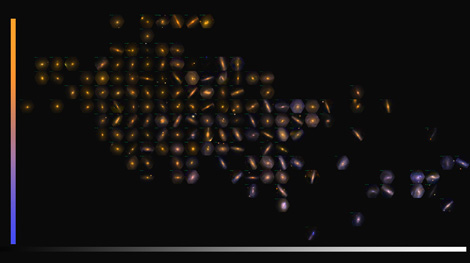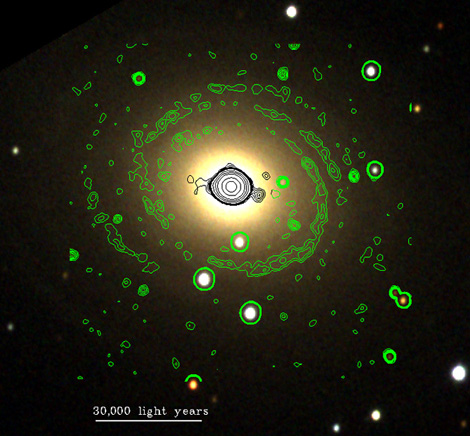 An international team, which includes two astronomers from the Astrophysics Center of the University of Porto, observed 100 nearby galaxies with a resolution never reached before.
An international team, which includes two astronomers from the Astrophysics Center of the University of Porto, observed 100 nearby galaxies with a resolution never reached before.
The project team CALIFA (Calar Alto Legacy Integral Field spectroscopy Area survey) has just made available data from the observation of the spectra of 100 nearby galaxies, of different masses and morphologies.
These data, obtained through IFS (Integral Field Spectroscopy, or integral field spectroscopy), have an unprecedented spatial resolution (4), allowing to trace the history of star formation in different zones of the galaxies.
For the CAUP astronomer and team member Polychronis Papaderos, "CALIFA is a high-impact international collaboration that will revolutionize our understanding of galaxy formation and evolution."
To do this, the team looks at the spectra of galaxies, one of the most important tools available to astronomers. However, it is generally only possible to measure the spectrum of the entire galaxy as, due to the distance, it is not possible to distinguish individual parts. In this way, the galaxy can only be described in general. Analogously, it would be like describing a city by saying that it is made only of buildings.

Recently, instruments have started to be developed that, through the technique known as IFS, make it possible to observe the spectrum of individual regions of galaxies. But one of the main difficulties in using this technique is that data analysis is quite complex and time-consuming. To solve the problem, astronomers at CAUP Jean Michel Gomes and Polychronis Papaderos developed a pipeline (6) that allows analyzing this data efficiently.
For Gomes, "our pipeline, with high computational performance, requires many hours of work to extract the most relevant astrophysical information, such as the movement of gas and stars."
Among the most important findings is the confirmation that many elliptical galaxies have ionized gas throughout their entire range. For a long time, astronomers thought these were “dead” galaxies, with only ionized gas in the core.
However, the existence of gas in all its extension, in this type of galaxies, was confirmed precisely through the detection of characteristic but very faint stripes in the spectra obtained by CALIFA. The team's observations will now be essential to clarify the origin of this gas and the energy source for its ionization.
The consortium's ultimate goal is to achieve detailed observations of 600 galaxies in the nearby Universe.
Author Ricardo Cardoso Reis (CAUP)
Science in the Regional Press – Ciência Viva
Image Credits: a) P. Papaderos; b) JM Gomes, P. Papaderos, JM Vilchez, C. Kehrig/CALIFA.

Notes:
1. The Astrophysics Center of the University of Porto (CAUP) was created in May 1989 and started its activities in October 1990. It is a non-profit private scientific and technical association of the University of Porto, recognized as being of public utility. Its objectives include supporting and promoting Astronomy through scientific research, training at postgraduate and university levels, teaching Astronomy at non-university level (basic and secondary) and disseminating science and promoting scientific culture.
It is the largest research institute in Astronomy in Portugal, with more than 60 people. Since 2000, it has been evaluated as “Excellent” by international panels, organized by the Foundation for Science and Technology (FCT).
2. The CALIFA consortium is formed by the following institutions: Astrophysical Institute, Academy of Sciences of the Czech Republic, Czech Republic; Australian Astronomical Observatory, Australia; Centro Astronomico Hispano Alemán, Spain; Center for Astrophysics at the University of Porto, Portugal; Institut d'Astrophysique of Paris, France; Institute of Astrophysics of Andalucia, Spain; Instituto de Astrofisica de Canarias, Spain; Institute of Physics of Cantabria, Spain; Laboratoire d'Astrophysique de Marseille, France; Leibniz Institut für Astrophysik, Potsdam, Germany; Max-Planck Institute for Astronomy, Germany; Observatoire de Paris, France; Peking University – Kavli Institute for Astronomy and Astrophysics, China; Royal Military College of Canada, Canada; Tianjin Normal University, China; Autonomous University of Madrid, Spain; Complutense University of Madrid, Spain; University of Granada, Spain; University of Zaragoza, Spain; University of Bochum, Germany; Cambridge University, UK; University of Copenhagen – Dark Cosmology Centre, Denmark; University of Edinburgh, UK; University of Groningen – Kapteyn Astronomical Institute, Netherlands; University of Heidelberg – Landessternwarte Königstuhl, Germany; University of Lisbon, Portugal; University of Missouri-Kansas City, USA; University of Sydney, Australia; University of Vienna, Austria.
3. The article “CALIFA, the Calar Alto Legacy Integral Field Area Survey: II. First public data release” was submitted for publication in the journal Astronomy & Astrophysics.
4. Spatial resolution is the threshold beyond which an instrument can separately distinguish two different lines, or the size of the smallest detail that can be measured with that instrument. As an example, the spatial resolution of a computer monitor is 72 lines per inch, while that of a printed magazine is 300 lines per inch.
5. A spectrum results from the decomposition of electromagnetic radiation (in the broad sense, the “light”) emitted by an object, into the various frequencies (or colors) that constitute it. The spectra have stripes, which act as a “fingerprint” of the elements that make up the observed object. The best known manifestation of this phenomenon is the decomposition of white sunlight into its constituent colors to form a rainbow.
6. A pipeline is a set of computer programs that work automatically, similar to an assembly line in a factory. The parts enter an assembly line, which are assembled automatically, with the product leaving fully assembled at the end of the line. Analogously, the pipeline receives the raw data from the telescope, this goes through a series of automatic analyses, and arrives at the astronomers ready to be analyzed.


















Comments